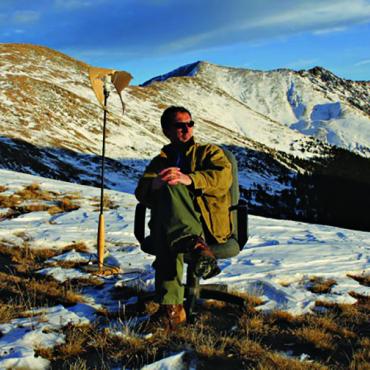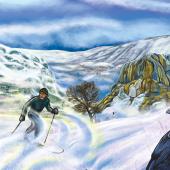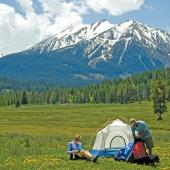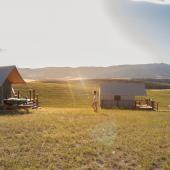Flaming Sugar and Fear
“Careful with that stick,” I warned Tanner, my five-year-old nephew, as he waved it wildly about like a symphony conductor testing a new baton.
“Don’t worry,” assured Missy, my sister. “Tan wouldn’t hurt a fly.”
Three minutes later, Tanner plunged the stick through my rain fly.
I didn’t get mad. I was, after all, honoring a promise to guide them on a short overnight backpacking trip and introduce Tanner to camping’s heavy wow-factor. The promise spawned from photos Missy showed me of her family camping at a KOA. Now, KOA serves its purpose extremely well, but unless you think seeing a june bug floating in a chlorinated swimming pool is wildlife, KOA is low on the outdoor-adventure scale.
I had procrastinated on my camping promise for months but finally followed through after reading that the majority of today’s kids are growing up without an appreciation for the outdoors. The theories for this statistic are many. Some blame the two-dimensional dominance of computers and TV screens. The fact that PBS glibly advertises its own DVDs on its website, which also proclaims “immerse yourself in the great outdoors without ever leaving your desk,” bolsters this indictment.
Others, such as Richard Louv (author of Last Child in the Woods, a brain-charging book on society’s nature-deficit disorder), blame it on steadfast parental beliefs that unless a child plays soccer or is involved in around-the-clock organized group activities, he or she is wasting time.
I blame adult-induced mind-bending fear.
To a child, camping in a forest represents quick access to an organic toy box. A rock to us is just a rock, but to a kid it’s a spaceship, a dinosaur egg, or what get lefts behind when The Thing from the Fantastic Four has liposuction (or at least that’s what I told Tanner, to my sister’s angst). But for whatever reason, adults insist on staining the camping experience with abject terror.
Sleeping in a tent, especially in bear country, can be frightening for kids. Every snap of a stick outside the camp’s dark perimeter ignites horrific fears of an approaching wild beast full of rage and wrath. Yet, to calm these exaggerated apprehensions, adults inexplicably encourage the kids to roast marshmallows and share ghost stories just before bedtime. And nothing better prepares a young child for a sound night of sleep than flaming sugar and fear. Consequently, for the next six hours, the kids are jacked on sugar while trembling in their tents, convinced they'll never live to see the light of day.
Why do adults blindly insist on the marshmallow-and-ghost-story entertainment combo when camping? At home, they would never conceive of saying, “Hey kids it’s almost time to tuck in for the night, but first we’re going to watch The Exorcist and pop amphetamines!” Imagine how drowsy you’d feel if an hour before climbing into bed on a Tuesday night you decided to sip four cans of boiling Red Bull while watching Suze Orman proclaim the dire consequences of having insufficient retirement funds. Instead of fostering a lifelong love for camping, the experience leaves kids emotionally scarred for life.
And if marshmallows were not sugar-lethal enough, s’mores are now becoming the number-one snack choice on camping’s food-and-fright plan. S’mores consist of marshmallows, graham crackers, and milk chocolate, or what I like to call the Three Riders of the Sugar Apocalypse. If ground beef and potatoes wrapped in foil can be called Hobo Stew, then s’mores should be called Hobo Speed.
Hollywood also deserves blame. In every film director’s mind, tents and campfires are land-chum for attracting evil hellhounds intent on strange and twisted terror. Any movie with a camping scene inevitably involves probing aliens, rogue bears, long-dormant witches, men in goalie masks who terrorize camping areas favored only by beautiful co-eds, or even worse, hooting owls. As a result, every human being, regardless of outdoor experience, automatically becomes dumbfounded and paralyzed with fear over the sound of “hoo-hoo.” Hear an owl hoot in a movie and it is immediately followed by campers shrieking, “What’s that?!”
What do they mean, “What’s that?” How many other species on this planet make a sound that is a direct, indirect, or implied question? Outside of a common loon, it’s the most identifiable bird sound known to man and no more puzzling than a car horn. Yet Hollywood steadfastly believes “hoo” is the lynchpin to all outdoor fear by treating it as an acronym for “Humans Outrageously Overreact.”
So because of this warped insistence on associating the outdoors with endless fear, camping—in a child’s mind—is a voluntary form of death row that serves marshmallows as a last meal.
As adults, we forget that the backcountry has its own built-in fear-factor. It doesn’t need our help. Wilderness does a good job by itself of presenting fear in many expected and unexpected forms. I’m reminded of this now after just watching Tanner stumble over a tree root and spill his bowl of freeze-dried pasta, causing me to fear that if I don’t have kids of my own there’s a good chance Tanner could someday be one of my pallbearers.












